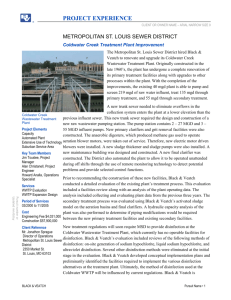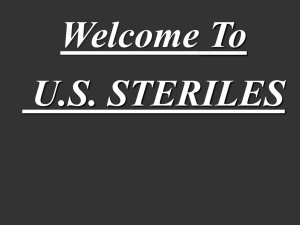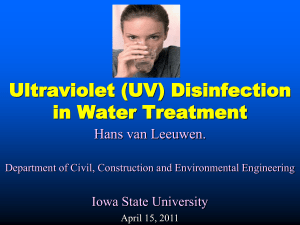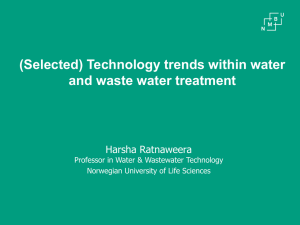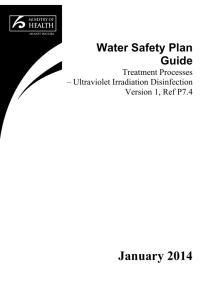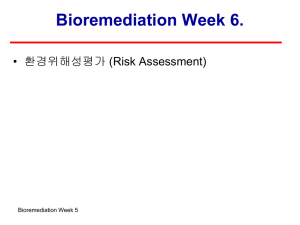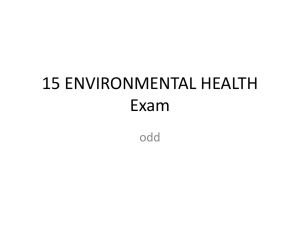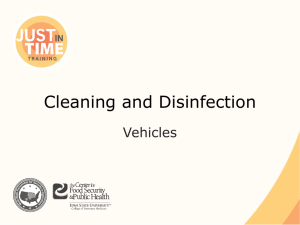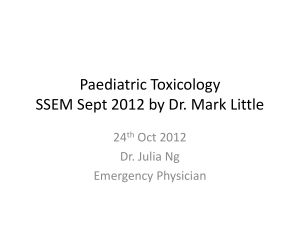Trojan Introduction Presentation
advertisement
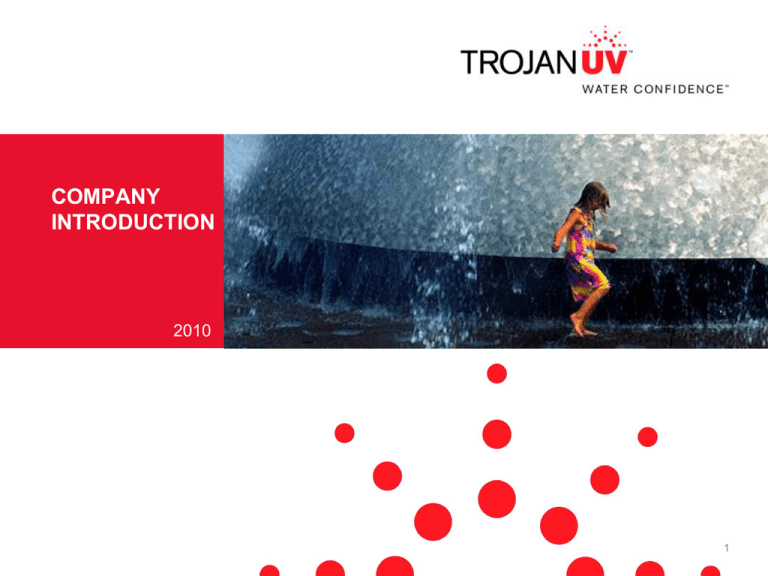
COMPANY INTRODUCTION 2010 1 AGENDA Introduction Core Business UV Basics and Advantages Capabilities Questions TROJAN FOUNDING PRINCIPLE Trojan is uniquely positioned to bring innovative, technologybased solutions to municipalities, industrial enterprises, and consumers to solve their water related and process problems in an environmentally responsible way. 3 TROJAN TODAY A Global Environmental Business with staff of 650 Canada US Europe China London & Guelph Multiple locations Multiple locations Multiple locations (400) (175) (50) (25) • Over 6,000 municipal UV installations on 6 continents, treating over 26 billion gallons/day, 4M m³/hr • UV for municipal, industrial, commercial and consumer applications • Environmental Contamination Treatment UV-H2O2 for removal of micropollutants, odour and corrosion control • Partnerships: Over 200 offices in 90 countries on 6 continents • Logistics & Manufacturing in Canada, US, Europe and China • Sales in 2009: US$ 220 M. 4 TROJAN UV COMPANY OVERVIEW • Over 30 years of UV water treatment experience • 650+ employees worldwide • Annual turnover of US$220M in 2009 • Thousands of UV installations in 6 continents • Worldwide sales & support • UV pioneers with dedicated R&D resources • ISO 9001 Certified, CE, DVGW, UL, CSA, NSF • Business unit of the Danaher Corporation (DHR) 5 DISINFECTION WATERBORNE MICROORGANISMS Microorganisms in drinking and waste water represent a risk to Public Health. Bacteria Viruses (E.coli) (Hepatitis, Polio) Protozoa (Giardia) (Cryptosporidium) 6 UV DISINFECTION HOW DOES IT WORK? UV light at the 254 nm wavelength penetrates the cell wall of the microorganism. The microorganism is “inactivated” and rendered unable to reproduce or infect. UV Energy Cell Wall Cytoplasmic Membrane DNA Nucleic Acid 7 UV AS PART OF MULTI-BARRIER STRATEGY Adenovirus Typical Chlorine CT for Giardia Chlorine UV Dose Disinfection Typical Design UV dose = 40mJ/cm2 Rotavirus Dual Protection Poliovirus Hepatitus A Streptococcus E.coli UV Disinfection Legionella Giardia Crypto Chlorine CT 8 WHY UV? ADVANTAGES • Effective against bacteria, viruses, and protozoan pathogens • No disinfection by-products formed • Not affected by pH, temperature • Easy maintenance and operation • Environmentally friendly technology • Economical alternative to other disinfection techs 9 CORE BUSINESS DISINFECTION Trojan develops, builds, sells and services innovative UV technologies for: 25,000Disinfection GPD to 1.5 MGD 1.5 MGD to 20 MGD Eg. Bacteria, Viruses, Spores Municipal Wastewater Municipal Drinking Water Private Potable Water Industrial Process Water Industrial Wastewaters Consumer Drinking Water 10 CORE BUSINESS ORGANICS DESTRUCTION Trojan develops, builds, sells and services innovative UV technologies for: 25,000Disinfection GPD to 1.5 MGD Eg. Bacteria, Viruses, Protozoa 1.5 MGD to 20 MGD Organics Destruction Eg. Total Oxidizable Carbon (TOC) Municipal Wastewater Groundwater Remediation Municipal Drinking Water Industrial Process Water Private Potable Water Industrial Wastewater Industrial Process Water Industrial Wastewaters Consumer Drinking Water 11 CORE BUSINESS CHEMICAL DESTRUCTION Trojan develops, builds, sells and services innovative UV technologies for: 25,000Disinfection GPD to 1.5 MGD Eg. Bacteria, Viruses, Spores Municipal Wastewater Municipal Drinking Water Private Potable Water 1.5 MGD Chemical to 20Destruction MGD Eg. Pesticides, oils, taste and color, corrosives medicines, carcinogens… Municipal Wastewater Municipal Drinking Water Organics Destruction Eg. Total Oxidizable Carbon (TOC) Groundwater Remediation Industrial Process Water Industrial Wastewater Groundwater Remediation Industrial Process Water Industrial Process Water Industrial Wastewaters Consumer Drinking Water Industrial Wastewater 12 UV DESINFECTION SYSTEMS 13 UV SYSTEM KEY COMPONENTS Control Panel with Visual Displays & Alarms UV Lamps UV Sensor Power Supply (Ballasts) Quartz Sleeves Sleeve Wiping System Reactor Chamber 14 ADVANTAGES OF UV DISINFECTION UV disinfection is a physical process No hazardous or toxic chemicals are used, eliminating public health concerns associated with THMs, HAAs or other carcinogenic by-products UV inactivates a broad spectrum of pathogens, including Giardia and Cryptosporidium Inactivation of chlorine-resistant parasites protect downstream recreational waters and surface waters used as a potable water source UV disinfection takes only seconds to inactivate organisms Since the contact times are short, the footprint required is minimal and existing chlorine contact tanks can be reused 15 ADVANTAGES OF UV DISINFECTION UV disinfection does not leave a residual disinfectant No de-chlorination or residual monitoring is required, which greatly reduces operation and maintenance costs Receiving waters are not negatively impacted and there is no risk of overdosing UV is an accepted, proven technology in thousands of installations around the world UV is easily designed by consulting engineers and approved by regulatory bodies, thereby reducing engineering costs and reducing permit approval time Upgradeable to UV oxidation or photolysis system Treatment process can be upgraded to treat emerging contaminants, offsetting upgrade costs in the future 16 ULTRAVIOLET (UV) LIGHT 17 HOW DOES UV WORK? • UV light penetrates the cell wall • The UV energy permanently alters the DNA of the microorganism • Microorganisms are “inactivated” and unable to reproduce or infect UV Energy Cell Wall DNA Nucleic Acid 18 MECHANISM OF UV DISINFECTION A C G T G C T A A A T T C A G G T C DNA Double Strand UV DNA A C G T G C T A A A T T C A G G T C Dimerization of Thymine Nucleotides dimer 19 DEFINITION OF UV DOSE UV Dose = Intensity x Retention Time (mWs/cm2) (mW/cm2) (seconds) • Higher dose means greater DNA damage and more bugs are killed • Different bugs require different doses to achieve same kills (e.g. bacteria vs. viruses) 20 FACTORS AFFECTING UV DOSE Intensity Retention Time Equipment Parameters • Lamp Spacing • Reactor Design • Lamp Age • Sleeve Fouling (iron, calcium, etc) Water Quality Factors (related to upstream process) • Flow Rate • UV Transmittance • Turbidity • Solids 21 UV TRANSMITTANCE • The ability of light to transmit through water • The ratio of light entering the water to that exiting the water • Sample length of 1 cm UV Transmission Scale: 20% - 50% 50% - 70% • Primary Effluent • Blended Effluent • Lagoons • CSO, SSO • Secondary Effluent • Filtered Effluent • WW Reuse • Fixed Film Effluent > 70% • Post-membrane • High-level reuse • Contaminant destruction 22 THE EFFECTS OF PARTICLES Scatter UV Light Shade Particles UV Lamp Complete Penetration Incomplete Penetration limits DNA damage 23 QUARTZ SLEEVE FOULING What is Fouling? • Accumulation of organic and inorganic material on the quartz surface • Absorbs UV light and decreases UV dose available for disinfection • All water fouls submerged surfaces • Rate of fouling influenced by various site-specific factors (water quality, hydraulics and velocities, sleeve surface condition) 24 LAMP AGING • As lamps age the amount of UV output decreases • UV systems should be designed to deliver the required dose at the end of lamp life (EOLL) to ensure disinfection is met under worst case conditions • EOLL should be independently validated to guarantee the system meets the disinfection requirements 25 UV SYSTEM DESIGN CRITERIA Parameter Flow Rates Description Peak and Average UV Transmission (%) Water Quality Total Suspended Solids (mg/l) TSS size and density Total Iron (mg/l) Upstream Treatment Suspended Growth or Fixed Film Filtration? Performance Criteria UV Dose or Disinfection Limit Configuration Footprint or Headloss Limits Redundancy Regulated or preferred 26 UV SYSTEM VALIDATION • As microbes flow through a UV reactor they will all follow a different path • Some will receive a high dose and some a lower dose • To account for these differences, “Validated” reactors should be used • “Validation” involves a full-scale test of the UV system involving live microbes 27 BIODOSIMETERY DETERMINATION Develop UV dose response data under controlled laboratory conditions UV Lamp Sample Stirrer Collimated Beam Viable Microbial Population Step 1: 10 6 10 5 10 4 103 102 Challenge Organism Dose Response 101 10 20 30 40 50 Dose Dose Response Curve 28 BIODOSIMETERY DETERMINATION Step 2: Inject test organism into full scale reactor to measure inactivation. Use organism from same culture. Organisms in (No) Organisms out (N) UV Reactor 29 BIODOSIMETERY DETERMINATION Viable Microbial Population Step 3: Determine dose from data in Steps 1 and 2 10 6 Challenge Organism Dose Response 10 5 10 Inactivation of test organism in reactor 4 10 3 10 2 10 1 UV Dose equivalent delivered by the reactor 10 20 30 40 Dose 50 30 GERMICIDAL UV LAMPS 32 UV LIGHT AND ABSORBANCE 254 nm LP lamp spectrum 100 80 RELATIVE UNITS 60 40 DNA Damage 20 10 8 6 EColi inactivation MP lamp spectrum 4 2 200 220 240 260 UVC 280 300 nm UVB 33 QUESTIONS? QUESTIONS? Thank you for your co-operation and attention. 34

